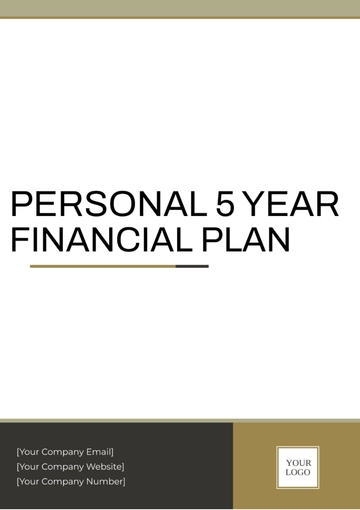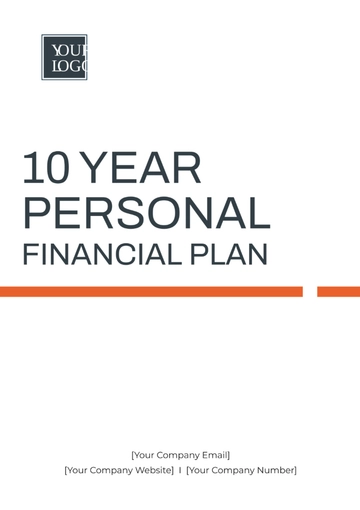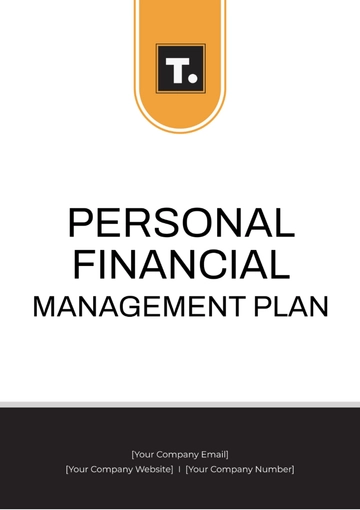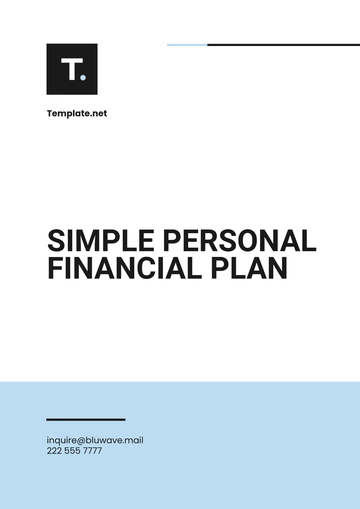Free Personal 5 Year Financial Plan

Written by: [Your Name]
I. Executive Summary
[Your Name]'s Personal 5-Year Financial Plan aims to establish a clear roadmap for achieving financial stability and prosperity over the next five years. This comprehensive plan outlines strategies to manage income, expenses, investments, and savings effectively, ensuring financial goals are met and wealth is accumulated.
II. Objectives
Financial Stability: Secure a stable financial foundation by minimizing debt and maximizing savings.
Investment Growth: Grow investment portfolio by 8% annually to achieve long-term wealth accumulation.
Retirement Planning: Develop a robust retirement plan to ensure a comfortable lifestyle post-employment.
Emergency Fund: Establish and maintain an emergency fund equivalent to 6 months' worth of expenses.
Budget Optimization: Implement strategies to optimize budgeting and expenditure, ensuring financial resources are utilized efficiently.
Asset Diversification: Diversify assets across various investment vehicles to mitigate risks and maximize returns.
III. Current Financial Snapshot
A. Income
Salary/Wages: $80,000 per year
Additional Income: $500 per month (e.g., rental income, freelance work)
Total Annual Income: $86,000
B. Expenses
Monthly Expenses: $3,000 per month
Annual Expenses: $36,000
Debt Payments: $500 per month (e.g., mortgage, loans)
C. Assets
Cash: $20,000 in savings accounts
Investments: $50,000 in stocks, bonds, mutual funds, etc.
Real Estate: Market value of owned properties: $300,000
D. Liabilities
Mortgage: Remaining balance: $200,000, Interest rate: 4%
Other Loans/Debts: Total outstanding balance: $30,000
IV. Financial Goals
A. Short-Term (1-2 Years)
Pay off Credit Card Debt: Eliminate all credit card debt within 12 months.
Build Emergency Fund: Accumulate 6 months' worth of expenses in the emergency fund.
Increase Savings Rate: Increase monthly savings contribution by 10% within 18 months.
B. Medium-Term (3-4 Years)
Purchase Investment Property: Acquire an investment property generating $1,500 in rental income.
Investment Portfolio Growth: Achieve 10% growth in investment portfolio value within 3 years.
Education Fund: Start saving for [Child's Name] college education with monthly contributions of $300.
C. Long-Term (5 Years and Beyond)
Retirement Planning: Contribute 15% of income to retirement accounts to ensure a comfortable retirement.
Net Worth Increase: Increase net worth to $500,000 by the end of the fifth year.
Charitable Giving: Allocate 3% of income for charitable donations and philanthropic endeavors.
V. Investment Strategy
A. Asset Allocation:
Stocks: 60%
Bonds: 20%
Real Estate: 15%
Cash: 5%
B. Investment Vehicles:
Index Funds: Allocate 40% of an investment portfolio to low-cost index funds.
Individual Stocks: Diversify stock holdings across 5 sectors for balanced growth.
Real Estate Investment Trusts (REITs): Invest 15% of real estate allocation in REITs for passive income.
C. Risk Management:
Regularly review and rebalance investment portfolio to maintain desired asset allocation.
Utilize a dollar-cost averaging strategy for systematic investment, reducing market timing risks.
Diversify across asset classes and geographical regions to minimize volatility.
VI. Action Plan
Debt Repayment: Develop a debt repayment plan focusing on high-interest debts first.
Emergency Fund: Set up automated transfers to emergency fund accounts to ensure consistent savings.
Budgeting: Track expenses using Mint, identifying areas for cost-cutting and optimization.
Investment Accounts: Open and fund investment accounts with Vanguard, allocating assets according to the investment strategy.
Retirement Accounts: Maximize contributions to employer-sponsored retirement accounts (e.g., 401(k), IRA).
Professional Guidance: Consult with a financial advisor to review and refine the financial plan periodically.
Continuous Learning: Stay informed about financial markets, investment opportunities, and personal finance best practices through books, seminars, and online resources.
VII. Monitoring and Review
Monthly Review: Review income, expenses, and investment performance monthly to track progress.
Quarterly Assessment: Assess budget adherence and adjust investment strategy quarterly if necessary.
Annual Review: Conduct a comprehensive review of the financial plan annually, updating goals and strategies as needed.
VIII. Risk Management
A. Insurance Coverage
Life Insurance: Coverage amount: $500,000, Policy type: term
Health Insurance: Coverage for John Doe and dependents, including dental and vision coverage.
Disability Insurance: Coverage amount: $3,000 per month, Waiting period: 3 months.
B. Contingency Planning
Job Loss: Maintain an emergency fund to cover 6 months' worth of expenses in case of unexpected job loss.
Health Emergencies: Ensure adequate health insurance coverage and savings to handle medical emergencies.
Market Volatility: Diversify investment portfolio and maintain a long-term perspective to mitigate market risks.
IX. Tax Planning
A. Tax-Efficient Investing
Maximize contributions to tax-advantaged accounts such as 401(k), IRA, and HSA.
Utilize tax-loss harvesting strategies to offset capital gains with investment losses.
B. Estate Planning
Establish a will and update beneficiary designations on accounts to ensure smooth wealth transfer.
Explore tax-efficient gifting strategies to minimize estate taxes for beneficiaries.
- 100% Customizable, free editor
- Access 1 Million+ Templates, photo’s & graphics
- Download or share as a template
- Click and replace photos, graphics, text, backgrounds
- Resize, crop, AI write & more
- Access advanced editor
Craft your financial destiny with Template.net's Personal 5-Year Financial Plan Template. Tailor your journey with this editable and customizable tool, exclusively available on Template.net. Seamlessly chart your financial course with ease using our Ai Editor Tool. Take control, plan smart, and pave the way to financial success. Get started today with Template.net's innovative solution.
You may also like
- Finance Plan
- Construction Plan
- Sales Plan
- Development Plan
- Career Plan
- Budget Plan
- HR Plan
- Education Plan
- Transition Plan
- Work Plan
- Training Plan
- Communication Plan
- Operation Plan
- Health And Safety Plan
- Strategy Plan
- Professional Development Plan
- Advertising Plan
- Risk Management Plan
- Restaurant Plan
- School Plan
- Nursing Home Patient Care Plan
- Nursing Care Plan
- Plan Event
- Startup Plan
- Social Media Plan
- Staffing Plan
- Annual Plan
- Content Plan
- Payment Plan
- Implementation Plan
- Hotel Plan
- Workout Plan
- Accounting Plan
- Campaign Plan
- Essay Plan
- 30 60 90 Day Plan
- Research Plan
- Recruitment Plan
- 90 Day Plan
- Quarterly Plan
- Emergency Plan
- 5 Year Plan
- Gym Plan
- Personal Plan
- IT and Software Plan
- Treatment Plan
- Real Estate Plan
- Law Firm Plan
- Healthcare Plan
- Improvement Plan
- Media Plan
- 5 Year Business Plan
- Learning Plan
- Marketing Campaign Plan
- Travel Agency Plan
- Cleaning Services Plan
- Interior Design Plan
- Performance Plan
- PR Plan
- Birth Plan
- Life Plan
- SEO Plan
- Disaster Recovery Plan
- Continuity Plan
- Launch Plan
- Legal Plan
- Behavior Plan
- Performance Improvement Plan
- Salon Plan
- Security Plan
- Security Management Plan
- Employee Development Plan
- Quality Plan
- Service Improvement Plan
- Growth Plan
- Incident Response Plan
- Basketball Plan
- Emergency Action Plan
- Product Launch Plan
- Spa Plan
- Employee Training Plan
- Data Analysis Plan
- Employee Action Plan
- Territory Plan
- Audit Plan
- Classroom Plan
- Activity Plan
- Parenting Plan
- Care Plan
- Project Execution Plan
- Exercise Plan
- Internship Plan
- Software Development Plan
- Continuous Improvement Plan
- Leave Plan
- 90 Day Sales Plan
- Advertising Agency Plan
- Employee Transition Plan
- Smart Action Plan
- Workplace Safety Plan
- Behavior Change Plan
- Contingency Plan
- Continuity of Operations Plan
- Health Plan
- Quality Control Plan
- Self Plan
- Sports Development Plan
- Change Management Plan
- Ecommerce Plan
- Personal Financial Plan
- Process Improvement Plan
- 30-60-90 Day Sales Plan
- Crisis Management Plan
- Engagement Plan
- Execution Plan
- Pandemic Plan
- Quality Assurance Plan
- Service Continuity Plan
- Agile Project Plan
- Fundraising Plan
- Job Transition Plan
- Asset Maintenance Plan
- Maintenance Plan
- Software Test Plan
- Staff Training and Development Plan
- 3 Year Plan
- Brand Activation Plan
- Release Plan
- Resource Plan
- Risk Mitigation Plan
- Teacher Plan
- 30 60 90 Day Plan for New Manager
- Food Safety Plan
- Food Truck Plan
- Hiring Plan
- Quality Management Plan
- Wellness Plan
- Behavior Intervention Plan
- Bonus Plan
- Investment Plan
- Maternity Leave Plan
- Pandemic Response Plan
- Succession Planning
- Coaching Plan
- Configuration Management Plan
- Remote Work Plan
- Self Care Plan
- Teaching Plan
- 100-Day Plan
- HACCP Plan
- Student Plan
- Sustainability Plan
- 30 60 90 Day Plan for Interview
- Access Plan
- Site Specific Safety Plan







